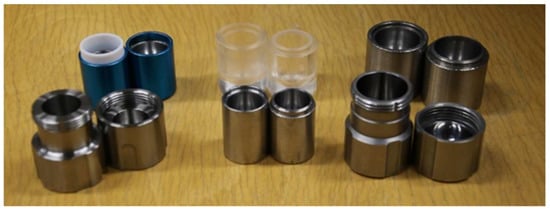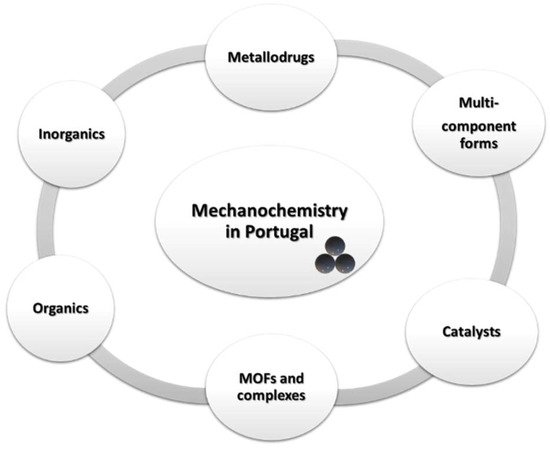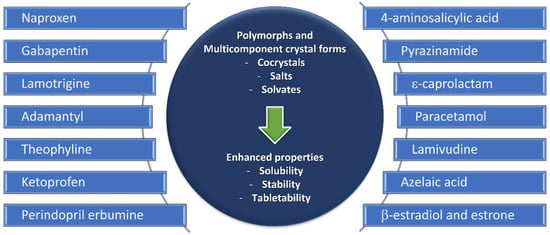
| Version | Summary | Created by | Modification | Content Size | Created at | Operation |
|---|---|---|---|---|---|---|
| 1 | Clara Gomes | + 1818 word(s) | 1818 | 2022-01-04 07:47:13 | | | |
| 2 | Rita Xu | Meta information modification | 1818 | 2022-01-24 05:17:29 | | |
Video Upload Options
In Portugal, publications with mechanochemical methods date back to 2009, with the report on mechanochemical strategies for the synthesis of metallopharmaceuticals. Since then, mechanochemical applications have grown in Portugal, spanning several fields, mainly crystal engineering and supramolecular chemistry, catalysis, and organic and inorganic chemistry.
1. Introduction
In 2019, a COST Action focused on “mechanochemistry for sustainable industry” (CA18112, MechSustInd) [26] was initiated, aiming to promote fundamental and applied research in mechanochemistry and its implementation in European industry. This collaborative network is composed of partners from 33 COST-member countries, including Portugal and the team involved in this review, as well as 17 other Inclusiveness Target Countries and partners worldwide. Currently, MechSustInd is represented by a total of 77 academic and other institutions in Europe and around the world.
1.1. Mechanochemical Methods

1.2. Mechanochemistry in Portugal
Figure 2 expands the applications of mechanochemistry in Portugal.

2. Developments of Mechanochemistry in Portugal
2.1. Mechanochemistry in the Synthesis of Polymorphs and Multicomponent Forms

2.2 Mechanochemistry in the Synthesis of BioMOFs and Coordination Polymers
The advantages of mechanochemistry in the field of metallodrugs, metallopharmaceuticals, and bio-inspired metal-organic frameworks (BioMOFs) has also been unveiled by Portuguese research teams [36][37][38]. Within BioMOFs and metal complexes, antibiotics have been exploited as ligands seeking synergistic effects with different biocompatible metal sources [37]. This approach leads to antibiotic coordination frameworks (ACFs) and was motivated by the need to increase the efficiency of antibiotics that are becoming less effective due to antimicrobial resistance mechanisms.
2.3. Mechanochemistry in/for Catalysis
The application of mechanochemistry for the synthesis of catalysts has also been growing over the last years, mainly due to its ease of synthesis scalability, and sustainability, as well as the superior properties of the resulting materials [39]. Since 2014, several Portuguese groups have been involved in the mechanosynthesis of catalysts.
2.4. Mechanochemistry in the Synthesis of Organic and Inorganic Compounds
Mechanochemistry has been widely employed in the synthesis of inorganic and organic compounds, proving to be a powerful, low-cost, and green method with significant benefits in relation to conventional synthetic methodologies. Several examples of both organic and inorganic materials join the class of compounds successfully produced by mechanochemistry, in Portugal.
3. Final Remarks
The history of mechanochemistry in Portugal is still recent, dating back to 2009. However, a lot of significative work has already been disclosed in a wide range of fields. Examples using NG, LAG, and ILAG via manual grinding, vibrational ball milling, and hot-melt extrusion have been reported.
The development of new crystal forms of pharmaceutical compounds based in crystal engineering and supramolecular chemistry is undoubtedly the area where more work has been carried out. Several studies show the possibility of using mechanochemistry for the synthesis of polymorphs, solvates, salts, cocrystals, and ionic cocrystals towards improved physicochemical properties. BioMOFs and ACFs prepared by mechanochemistry in quantitative yield and short reaction times have been reported as alternative drug forms with enhanced solubility and/or efficiency.
Nevertheless, other non-pharmaceutical-related areas have also been explored, with significant results. Topics such as ionic liquids and liquid crystals have also benefited from the application of this synthetic procedure. The preparation of catalysts by mechanosynthesis was accomplished in very short reaction times and in quantitative yields, and their application in catalytic reactions showed effective results both in homo- and heterogeneous media. Moreover, syntheses of a variety of organic and inorganic derivatives were also performed by several research groups, proving mechanochemistry as a powerful and green methodology with significant benefits in relation to conventional solution-based methods.
References
- Anastas, P.T.; Warner, J.C. Green Chemistry: Theory and Practice; Oxford University Press: New York, NY, USA, 1998; p. 30.
- United Nations. 17 Sustainable Development Goals. Available online: https://sdgs.un.org/goals (accessed on 21 December 2021).
- European Commission. A European Green Deal. Available online: https://ec.europa.eu/info/strategy/priorities-2019-2024/european-green-deal_en (accessed on 28 July 2021).
- Colacino, E.; Porcheddu, A.; Charnay, C.; Delogu, F. From enabling technologies to medicinal mechanochemistry: An eco-friendly access to hydantoin-based active pharmaceutical ingredients. React. Chem. Eng. 2019, 4, 1179–1188.
- Takacs, L. The historical development of mechanochemistry. Chem. Soc. Rev. 2013, 42, 7649–7659.
- Schiffmann, J.G.; Emmerling, F.; Martins, I.C.B.; Van Wüllen, L. In-situ reaction monitoring of a mechanochemical ball mill reaction with solid state NMR. Solid State Nucl. Magn. Reson. 2020, 109, 101687.
- Quaresma, S.; André, V.; Fernandes, A.; Duarte, M.T. Mechanochemistry—A green synthetic methodology leading to metallodrugs, metallopharmaceuticals and bio-inspired metal-organic frameworks. Inorg. Chim. Acta 2017, 455, 309–318.
- Beyer, M.K.; Clausen-Schaumann, H. Mechanochemistry: The mechanical activation of covalent bonds. Chem. Rev. 2005, 105, 2921–2948.
- Achar, T.K.; Bose, A.; Mal, P. Mechanochemical synthesis of small organic molecules. Beilstein J. Org. Chem. 2017, 13, 1907–1931.
- Yu, J.; Ying, P.; Wang, H.; Xiang, K.; Su, W. Mechanochemical Asymmetric Cross-Dehydrogenative Coupling Reaction: Liquid-Assisted Grinding Enables Reaction Acceleration and Enantioselectivity Control. Adv. Synth. Catal. 2020, 362, 893–902.
- Dabral, S.; Wotruba, H.; Hernández, J.G.; Bolm, C. Mechanochemical Oxidation and Cleavage of Lignin β-O-4 Model Compounds and Lignin. ACS Sustain. Chem. Eng. 2018, 6, 3242–3254.
- Fiss, B.G.; Richard, A.J.; Friščić, T.; Moores, A. Mechanochemistry for sustainable and efficient dehydrogenation/hydrogenation. Can. J. Chem. 2021, 99, 93–112.
- Chauhan, P.; Chimni, S.S. Mechanochemistry assisted asymmetric organocatalysis: A sustainable approach. Beilstein J. Org. Chem. 2012, 8, 2132–2141.
- Cave, G.W.V.; Raston, C.L.; Scott, J.L. Recent advances in solventless organic reactions: Towards benign synthesis with remarkable versatility. Chem. Commun. 2001, 21, 2159–2169.
- Rightmire, N.R.; Hanusa, T.P. Advances in organometallic synthesis with mechanochemical methods. Dalton Trans. 2016, 45, 2352–2362.
- Solares-Briones, M.; Coyote-Dotor, G.; Páez-Franco, J.C.; Zermeño-Ortega, M.R.; de la, O. Contreras, C.M.; Canseco-González, D.; Avila-Sorrosa, A.; Morales-Morales, D.; Germán-Acacio, J.M. Mechanochemistry: A Green Approach in the Preparation of Pharmaceutical Cocrystals. Pharmaceutics 2021, 13, 790.
- Głowniak, S.; Szczęśniak, B.; Choma, J.; Jaroniec, M. Mechanochemistry: Toward green synthesis of metal–organic frameworks. Mater. Today 2021, 46, 109–124.
- Yang, Y.; Zhao, W.; Niu, H.; Cai, Y. Mechanochemical Construction 2D/2D Covalent Organic Nanosheets Heterojunctions Based on Substoichiometric Covalent Organic Frameworks. ACS Appl. Mater. Interfaces 2021, 13, 42035–42043.
- van Wyk, L.M.; Loots, L.; Barbour, L.J. Mechanochemical control of solvent content in a 1D coordination polymer. J. Coord. Chem. 2021, 74, 190–199.
- Delori, A.; Friscic, T.; Jones, W. The role of mechanochemistry and supramolecular design in the development of pharmaceutical materials. CrystEngComm 2012, 14, 2350–2362.
- Karimi-Jafari, M.; Padrela, L.; Walker, G.M.; Croker, D.M. Creating Cocrystals: A Review of Pharmaceutical Cocrystal Preparation Routes and Applications. Cryst. Growth Des. 2018, 18, 6370–6387.
- Rodrigues, M.; Baptista, B.; Lopes, J.A.; Sarraguça, M.C. Pharmaceutical cocrystallization techniques. Advances and challenges. Int. J. Pharm. 2018, 547, 404–420.
- Fiss, B.G.; Vu, N.-N.; Douglas, G.; Do, T.-O.; Friščić, T.; Moores, A. Solvent-Free Mechanochemical Synthesis of Ultrasmall Nickel Phosphide Nanoparticles and Their Application as a Catalyst for the Hydrogen Evolution Reaction (HER). ACS Sustain. Chem. Eng. 2020, 8, 12014–12024.
- Gomollón-Bel, F. Ten Chemical Innovations That Will Change Our World: IUPAC identifies emerging technologies in Chemistry with potential to make our planet more sustainable. Chem. Int. 2019, 41, 12–17.
- Gečiauskaitė, A.A.; García, F. Main group mechanochemistry. Beilstein J. Org. Chem. 2017, 13, 2068–2077.
- Do, J.-L.; Friščić, T. Mechanochemistry: A Force of Synthesis. ACS Cent. Sci. 2017, 3, 13–19.
- Beldon, P.J.; Fábián, L.; Stein, R.S.; Thirumurugan, A.; Cheetham, A.K.; Friščić, T. Rapid room-temperature synthesis of zeolitic imidazolate frameworks by using mechanochemistry. Angew. Chem. Int. Ed. Engl. 2010, 49, 9640–9643.
- Friscić, T.; Reid, D.G.; Halasz, I.; Stein, R.S.; Dinnebier, R.E.; Duer, M.J. Ion- and liquid-assisted grinding: Improved mechanochemical synthesis of metal-organic frameworks reveals salt inclusion and anion templating. Angew. Chem. Int. Ed. Engl. 2010, 49, 712–715.
- Hasa, D.; Rauber, G.S.; Voinovich, D.; Jones, W. Cocrystal Formation through Mechanochemistry: From Neat and Liquid-Assisted Grinding to Polymer-Assisted Grinding. Angew. Chem.-Int. Ed. 2015, 54, 7371–7375.
- Hasa, D.; Carlino, E.; Jones, W. Polymer-Assisted Grinding, a Versatile Method for Polymorph Control of Cocrystallization. Cryst. Growth Des. 2016, 16, 1772–1779.
- Crawford, D.; Casaban, J.; Haydon, R.; Giri, N.; McNally, T.; James, S.L. Synthesis by extrusion: Continuous, large-scale preparation of MOFs using little or no solvent. Chem. Sci. 2015, 6, 1645–1649.
- Braga, D.; Grepioni, F.; Andre, V.; Duarte, M.T. Drug-containing coordination and hydrogen bonding networks obtained mechanochemically. CrystEngComm 2009, 11, 2618–2621.
- Andre, V.; Hardeman, A.; Halasz, I.; Stein, R.S.; Jackson, G.J.; Reid, D.G.; Duer, M.J.; Curfs, C.; Duarte, M.T.; Friscic, T. Mechanosynthesis of the Metallodrug Bismuth Subsalicylate from Bi2O3 and Structure of Bismuth Salicylate without Auxiliary Organic Ligands. Angew. Chem.-Int. Ed. 2011, 50, 7858–7861.
- Martins, I.C.B.; Oliveira, M.C.; Diogo, H.P.; Branco, L.C.; Duarte, M.T. MechanoAPI-ILs: Pharmaceutical Ionic Liquids Obtained through Mechanochemical Synthesis. ChemSusChem 2017, 10, 1360–1363.
- Desiraju, G.R. Crystal Engineering: The Design of Organic Solids; Elsevier: Amsterdam, The Netherlands, 1989.
- Pombeiro, A.J.L. (Ed.) Mechanochemistry: A Tool in the Synthesis of Catalysts, Metallodrugs and Metallophamacuticals. In ICOMC Silver/Gold Jubilee Celebratory Book; Wiley: Hoboken, NJ, USA, 2014.
- Andre, V.; Alves, P.C.; Duarte, M.T. Exploring antibiotics as ligands in metal-organic and hydrogen bonding frameworks: Our novel approach towards enhanced antimicrobial activity (mini-review). Inorg. Chim. Acta 2021, 525, 120474.
- Andre, V.; Quaresma, S.; da Silva, J.L.F.; Duarte, M.T. Exploring mechanochemistry to turn organic bio-relevant molecules into metal-organic frameworks: A short review. Beilstein J. Org. Chem. 2017, 13, 2416–2427.
- Amrute, A.P.; De Bellis, J.; Felderhoff, M.; Schuth, F. Mechanochemical Synthesis of Catalytic Materials. Chem.-Eur. J. 2021, 27, 6819–6847.




